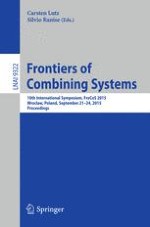This book constitutes the proceedings of the 10th International Symposium on Frontiers of Combining Systems, FroCoS 2015, held in Wroclaw, Poland, in September 2015.
The 20 papers presented in this volume were carefully reviewed and selected from 34 submissions. They were organized in topical sections named: description logics; theorem proving and model building; decision procedures; decision procedures for verification; rewriting and constraint solving; transformations between symbolic systems; combination methods; and reasoning in large theories. The book also contains one invited talk in full-paper length.
